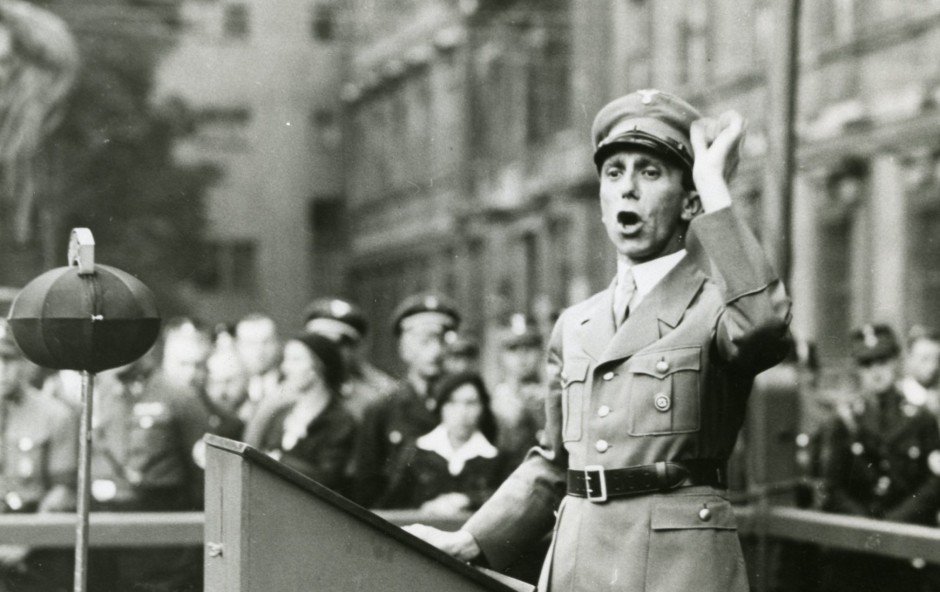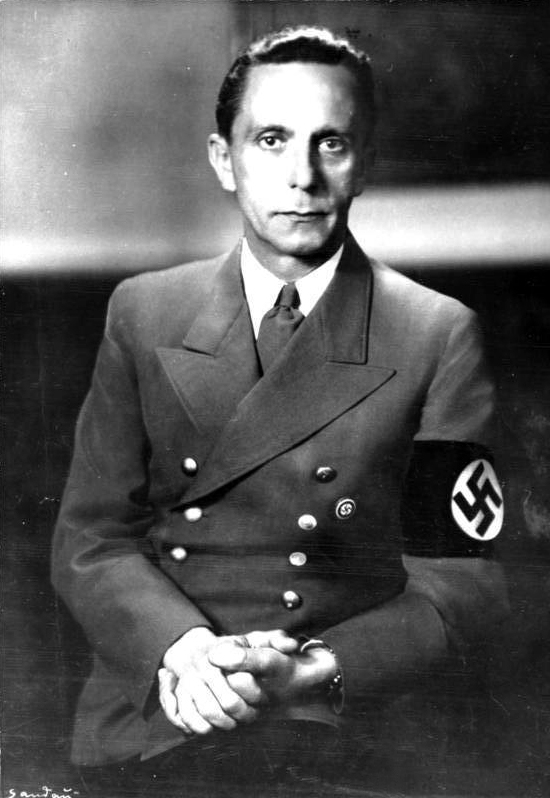
Joseph Goebbels, the minister of enlightenment and propaganda during the 12-year Nazi era, was probably Adolf Hitler’s most loyal deputy. Completely dedicated to him and his vision of a fascist, antisemitic order in Germany, Goebbels looked upon Hitler as his idol.
According to Goebbel’s latest biographer, Peter Longerich, a professor of modern German history at the University of London, he was “the only member of Hitler’s innermost circle to hold out in the (Berlin) bunker and ultimately follow him in committing suicide.”
In a radio address several months before Germany’s ignominious defeat in World War II, he declared that life would “not be worth living, either for myself or for my children,” should the Third Reich collapse. A day after after Hitler blew his brains out, Goebbels, true to his word, shot his wife and six children before shooting himself.
By killing himself and his family, Longerich writes in Goebbels: A Biography (Random House), an excellent work based in part on his voluminous diaries, Goebbels found a grisly way of demonstrating his absolute commitment to Hitler and his beliefs.
Goebbels, whom the author claims was driven by an exceptional and narcissistic craving for recognition, came out of nowhere. In 1923, a decade before the Nazi seizure of power, he was a nobody, an obscure, penniless, unsuccessful writer who had just been fired from his job as a bank clerk in Cologne and who was trying to make sense of the political and economic chaos gripping Germany. To help him sort out his thoughts during this turbulent period, he kept a diary, which he methodically maintained until the end.
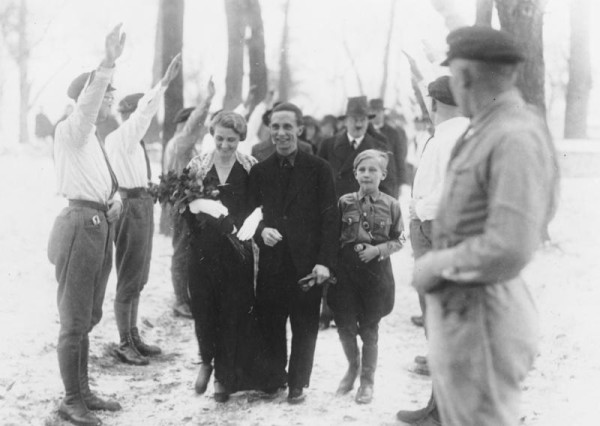
Born in the Lower Rhine industrial town of Rheydt in 1897, Goebbels was the son of a lowly factory clerk. Although he was hobbled by a clubfoot, he was a womanizer par excellence. As a student, politics left him cold. He tried his hand as a playwright and poet, but his talents were limited. He studied German literature and philology, among other subjects, and earned a PhD in philosophy.
Although he was prone to casual antisemitism, Goebbels was not a vociferous antisemite before joining the Nazi Party. His thesis advisors, Friedrich Gundolf and Max von Waldberg, were Jewish. And one of his girlfriends, a school teacher named Else Janke, was half-Jewish. Goebbels was less than pleased by her partial Jewish ancestry, but in 1919, he wrote, “I don’t particularly like this exaggerated antisemitism. I can’t say that the Jews are my best friends, but I believe you can’t rid the world of them through cursing and polemics or even through pogroms, and even if you could, it would be demeaning and beneath human dignity.”
In 1924, lacking direction and socially isolated, Goebbels gravitated toward the National Socialists. By then, Longerich observes, his antisemitism had grown significantly. “The Jews are the poison that is destroying the body of Europe,” he noted in his diary.
‘The origins of his hostility toward ‘the Jews’ were very simple,” Longerich explains. “He was looking for a scapegoat for the serious economic, political and cultural crises of the times. Antisemitism provided him with a convenient substitute for a social analysis of which he was incapable. The Jews represented for him the opposite of what was ‘German,’ which remained indistinct and idealistic.”
From the outset, he was captivated by Hitler. “What is liberating about Hitler is the way he commits himself as a truly upright and honest personality,” he wrote.
Having read Henry Ford’s antisemitic tract, The International Jew, and the Russian forgery, The Protocols of the Elders of Zion, he was now preoccupied with the “Jewish question,” which, he claimed, was “the burning question of the hour.”
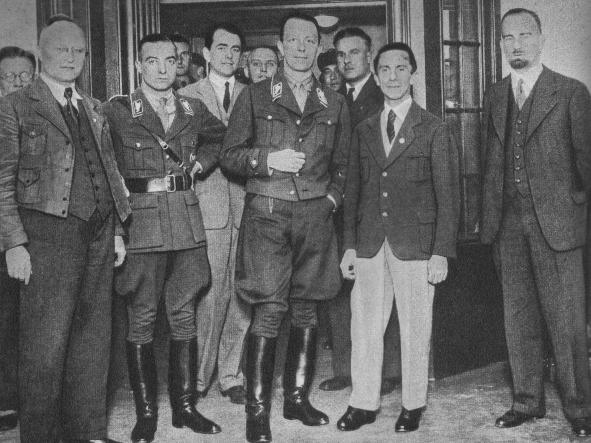
He and a friend founded a weekly newspaper, Volkische Freheit, which promoted the nascent Nazi cause and regarded Hitler as a savior of the German people. Goebbels, however, did not meet Hitler personally until the summer of 1925. And he was smitten. “What a voice, what passion. Just as I wished him to be.” He added, “I’m a different person … I’m ready to sacrifice everything for him.” Presciently enough, he wrote, “The man has all it takes to become king. The coming dictator.”
Hitler appointed him party leader in Berlin in 1926. In short order, he created a cult around the figure of the late Horst Wessel, a Nazi thug. And in 1931, he had his men jostle, abuse and beat up Jews on one of Berlin’s main thoroughfares.
As Longerich suggests, Hitler, a bachelor, was close to Goebbels and his wife, Magda. Their apartment became a refuge for Hitler, who was fond of their children, all of whose names would begin with the letter “h.” The fuhrer especially liked Magda, whom he admired as the loveliest, dearest and cleverest of women.
Goebbels’ plan as minister was straightforward. He would attempt to “work on people until they accept our influence.” He achieved this objective through lavish festivities and pageants featuring colorful posters and banners, mass meetings and propaganda campaigns, Longerich says.
He played a key role in the one-day economic boycott of German Jews in April 1933 — the first centrally directed antisemitic drive launched by the Nazi regime. And he was the official speaker at a public book burning event in Berlin in May. Oddly enough, though, he was not involved in the making of Leni Riefenstahls’ brilliant propaganda film, The Triumph of the Will, which, he had predicted, would come to nothing.
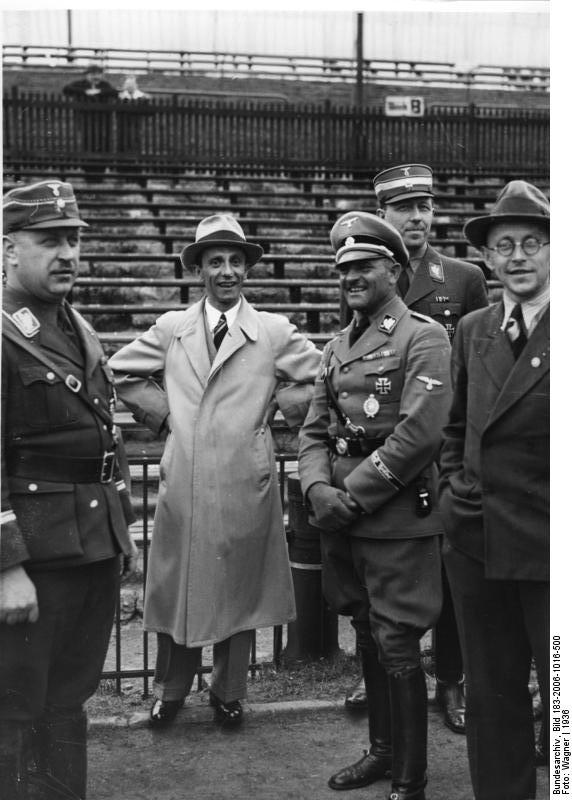
But Goebbels was very much active in muzzling the free press, reorganizing the film industry and reorienting art. He was behind the closure of many newspapers. At Hitler’s suggestion, he ordered the production of a series of blatantly anti-Jewish films, most notably Jud Suss, The Rothschilds and The Eternal Jew. And he organized the infamous Exhibition of Degenerate Art, which included paintings by Emil Nolde and Marc Chagall.
Goebbels was at the center of diplomatic maneuvers that led to an improvement of Germany’s bilateral relations with Poland in 1934. But as Longerich points out, he was left out of the loop with respect to other major foreign policy initiatives.
During the 1936 Olympic Games in Berlin, he ordered the mass media to exercise restraint over the so-called Jewish question. But in the following year, he and Julius Streicher, the arch antisemite, jointly opened the exhibition The Eternal/Wandering Jew. On Hitler’s order, he drew up legislation forbidding Jews to visit theaters and cultural events. “The Jews have to get out of Germany, out of the whole of Europe, in fact,” he wrote. “It will take time, but it must and will happen.”
Several months prior to Kristallnacht, in November 1938, Goebbels orchestrated attacks against Jews and Jewish businesses and synagogues. He camouflaged these assaults as signs of “popular anger.” As this thuggery unfolded, Hitler forced Goebbels to give up his mistress, the Czech actress, Lida Baarova.
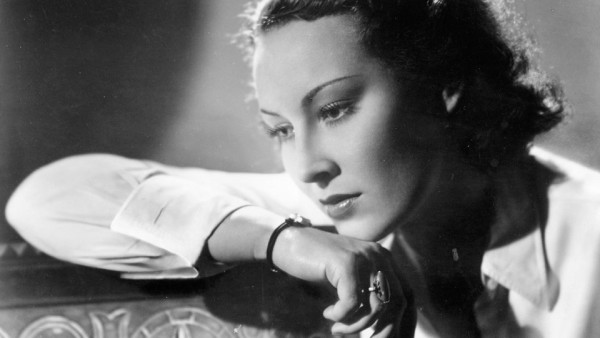
Of course, Goebbels stoked the fires of Kristallnacht, the nation-wide pogroms which convulsed Germany. “The people’s anger is raging now. There’s no stopping it … Not that I want to. Let it rip … The synagogues are burning in every major city.”
In the wake of Kristallnacht, the Jewish question became the dominant theme of German propaganda, with Goebbels proposing that Jews be banned from all public places, including forests and schools, and claiming that Jews were responsible for tensions in Europe.
With the outbreak of war, Goebbels’ antisemitism deepened. Following a tour of the Jewish quarter of Lodz, he wrote, “These are no longer people, they are animals. So our task is not a humanitarian one but a surgical one. Incisions will have to be made, and quite radical ones at that. Otherwise Europe will be destroyed by the Jewish sickness.” Debriefing Hitler, he said, “The Jews are a waste byproduct.”
After Germany’s conquest of France in 1940, Goebbels demanded that Berlin should be the first German city made “free of Jews.” With Germany’s invasion of the Soviet Union, the press and newsreels produced a flood of antisemitic tirades to underscore the symbiosis between Bolshevism and Jews. In a direct reference to Jews, he said, “The enemy of the world shall fall, and Europe shall have peace.”
In 1941, he launched a campaign to prepare Germans for the introduction of the demeaning yellow star, which every Jew would be forced to wear. As the deportation of German Jews commenced in that year, his propaganda focused on the existence of a Jewish world conspiracy bent on destroying Germany.
Upon visiting the Vilna ghetto, he wrote, “The Jews are lice that live on civilized humanity. They must somehow be exterminated, otherwise they will keep on tormenting and oppressing us.”
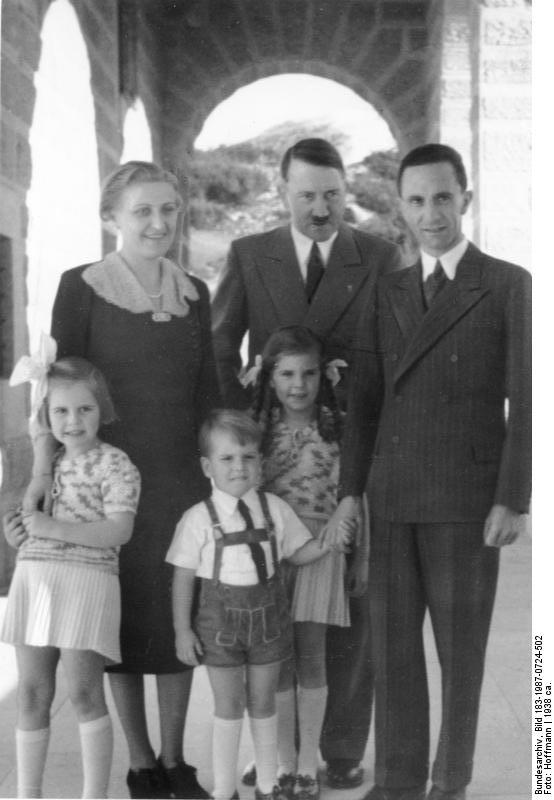
On the eve of the 1942 Wannsee conference, which set into motion the systematic murder of European Jews, he wrote that Jews “are experiencing a fate which, while hard, is more than deserved.” Jews were suffering “a gradual process of annihilation,” he continued. Elaborating on this point, he noted, “As far as the Jewish question is concerned, the fuhrer is determined to make a clean sweep of it. He had prophesied to the Jews that if they brought about another world war, they would experience their annihilation. That was not empty talk … The annihilation of Jewry must be the inevitable consequence. The question must be regarded without any sentimentality.”
On the heels of the Wannsee conference, Goebbels declared that a “final solution” was necessary. “Later generations won’t have the drive and the instinct for this, so it’s good that we are being radical and decisive.”
With the Holocaust unfolding in Poland, he wrote euphemistically, “A fairly barbaric procedure, not to be described in any detail, is being used here, and not much is left of the Jews themselves.” After discussing the Jewish issue with Hitler, he wrote, “The Jews have caused us so much suffering … that the toughest punishment we can impose is still too mild for them.”
In 1943, with the war starting to go badly for Germany, Goebbels called for “total war,” demanding the conscription of women into the labor market, the closure of companies superfluous to the war effort and the shuttering of luxury shops and expensive restaurants. His rivals, including Hermann Goering, dismissed the proposal, and it was not implemented until 1944.
He had other problems, too. Germans still married to Jews resisted efforts to deport them, prompting him to write, “Unfortunately, the upper classes … don’t understand our Jewish policy, and some of them support the Jews.”
By Longerich’s estimation, the high point in the anti-Jewish propaganda campaign occurred in May of 1943, when Das Reich, a journal in which Goebbels’ diatribes were published, blamed Jews for igniting the war and portrayed them as the “cement that is holding the enemy coalition together.”
According to Longerich, the effect of the antisemitic campaigns on Germans was ambivalent. As he puts it, “Apart from positive reactions it also produced irritation and opposition.” And in many cases, he goes on to say without elaboration, the population rejected the claim that Jews were entirely responsible for the war.
As Hitler withdrew from the public realm, delivering fewer speeches, Goebbels increasingly assumed the title of chief orator, often harping on Jewish themes. After conversing with SS chieftain Heinrich Himmler in 1944, he wrote, “He is convinced that by the end of the year we can solve the Jewish question for the whole of Europe. He advocates the most radical and toughest solution, namely to exterminate the Jews, the whole lot of them. That is certainly a consistent, albeit brutal solution.”
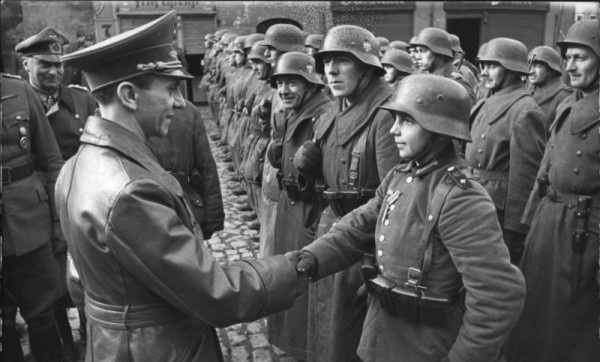
As the Red Army smashed the Wehrmacht on the eastern front, Goebbels proposed a separate peace with the Soviet Union, but Hitler rejected the proposal. At one juncture, Goebbels expressed growing doubts about Hitler’s leadership qualities, but he recanted.
Fanatical as he was, Goebbels gradually realized that Germany could not win the war. This point was particularly driven home after his ministry was obliterated by an Allied air raid. Yet he stayed close to the man he idolized. In a radio broadcast on February 28, 1945, he acknowledged that life would no longer be worth living if Germany was defeated. In accordance with his wishes, subordinates burned his body, and the bodies of his family, after their gruesome deaths.
“By following Hitler’s example and committing suicide with his family, he had confirmed for all time the special relationship he believed he had with his idol,” Longerich concludes in this masterful book.
